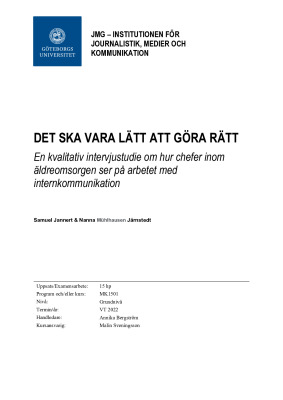DET SKA VARA LÄTT ATT GÖRA RÄTT
En kvalitativ intervjustudie om hur chefer inom äldreomsorgen ser på arbetet med internkommunikation
Executive summary
Internal communication within public organizations is a vital part in making them function and to reach organizational strategic goals, however it is also somewhat forgotten. This is partly due to the glorification of external communication, but also beacuse external communication being easier to measure and its visibility outside of the organization.
Our aim was to explore how first line managers regard their communicative responsibilities and how they view the conditions they are working under to fulfill this responsibility. The questions we’ve aimed to answer are how first line managers’ knowledge and presumptions revolving internal communication and their communicative responsibility, how first line
managers work with internal communication in their operations and if the managers experience any need of support to be able to improve their internal communication.
We have conducted five semi-structured interviews with first line managers in Gothenburg elderly, health, and social care. The main results of the study were that the managers do have quite the understanding of the importance of internal communication although they sometimes struggled to put it into words. They struggled to achieve sensemaking communication in an organization that still clings on to a view of communication as a transfer
of information, especially higher up in the organizational hierarchy. Of course the managers did not provide uniform answers, we believe that factors such as age and years in managerial position affects their view of communication in general and internal communication in particular.
Our results can provide future researchers with a basic understanding of the challenges first line managers face in trying to achieve dialogue and sensemaking communication, and trying to turn the headwind they are sometimes working in into tailwind.
We propose researching how the CVC model might be used to expose the complexity of communication, and if that might contribute to a higher status in the technostructure. Another interesting field of research would be on how to design educations in communication for first line managers in the elderly care.
We can conclude that there is a long way to go until our studied organization truly becomes a communicative organization, but as more and more first line managers climb up in the organizational hierarchy this might change in a not too distant future.
Keywords: Internal communication, communicative organization, first line managers, elderly and social care.

